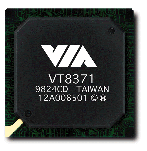VIA Apollo KX133 Athlon Chipset - Part 1
by Anand Lal Shimpi on February 7, 2000 11:51 PM EST- Posted in
- CPUs
 The
first “new” part of the KX133 is the 371 North Bridge, but even the 371 North
Bridge borrows some features and technology from VIA’s other flagship North
Bridge, the 694X. Let’s look at the 371’s features:
The
first “new” part of the KX133 is the 371 North Bridge, but even the 371 North
Bridge borrows some features and technology from VIA’s other flagship North
Bridge, the 694X. Let’s look at the 371’s features:
· High Performance Athlon CPU Interface – All this fancy statement means is that the 371 interfaces with the Slot-A connector on the motherboard using the Athlon’s EV6 bus. This interface is the “200MHz FSB” that most Athlon motherboard manufacturers throw around when it’s actually a 100MHz Double Data Rate FSB. This implementation remains relatively unchanged from the original AMD 751 North Bridge, meaning that the amount of available bandwidth has not changed (1.6GB/s).
· Fully Featured Accelerated Graphics Port (AGP) Controller – The 371’s integrated AGP controller is actually borrowed from VIA’s 694X AGP controller in that they both feature the same core. The controller features support for AGP 1X, 2X and 4X transfer rates, and because of its AGP 4X support, motherboard manufacturers can choose to implement an AGP Pro connector on motherboards based on the KX133 chipset. This is an improvement over the AGP 2X limitation of the AMD 751 North Bridge.
· Concurrent PCI Bus Controller – The integrated PCI controller is the same as the 694X’s (Apollo Pro 133A) PCI bus controller. It supports 5 PCI master devices, but motherboard manufacturers can implement more than 5 PCI slots, the added slots will simply be slave devices. Nothing special here.
· Advanced High-Performance DRAM Controller – The Memory subsystem of the KX133 is the biggest difference between the 371 North Bridge and the AMD 751 North Bridge. The 371 can address up to 8 RAS lines, meaning motherboard manufacturers can outfit their boards with up to 4 DIMM slots with support for double sided DIMMs in all of the slots.
The memory controller, once again, very closely resembles that on the 694X (Apollo Pro 133A), especially in the supported memory types. The 371 currently only supports PC133 and PC100 SDRAM (no DDR SDRAM support) as well as VC133 and VC100 Virtual Channel SDRAM support.
The memory bus can operate (officially) at either 100MHz or 133MHz, this is an improvement over the sole 100MHz setting present on motherboards based on the AMD 750 chipset. Keep in mind that we’re talking about the memory bus frequency, not the front side bus frequency, the latter which operates at 100MHz DDR regardless of the frequency of the memory bus. The 133MHz memory bus frequency allows the KX133 to attain an available 1.06GB/s of peak memory bandwidth, up from the 800MB/s on the AMD 750. This is the biggest improvement the KX133 offers over the AMD 750.
The chipset itself supports up to 2GB of memory, but it’s up to the motherboard manufacturers to make sure that their boards can reach this capacity properly without sacrificing stability.
Because most of the 371 chip itself is borrowed from the 694X (with the obvious exception of the interface to the EV6 bus), functions such as AGP 4X and the 133MHz memory bus frequency shouldn’t have any related problems since we’ve already seen them in action on Apollo Pro 133A boards.










0 Comments
View All Comments